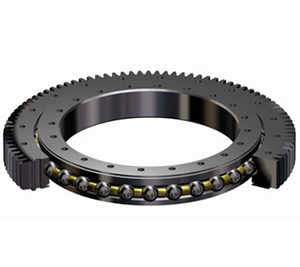
1. The slewing bearing is not sensitive to rolling.
The slewing bearing has passed strict inspection and test work before leaving the factory, and it is a qualified product. Therefore, if there is a retention phenomenon, the following methods can be used to eliminate it.
(1) Newly purchased products are not sensitive to idling. Please check the production date of the slewing bearing. If it takes a long time (such as more than half a year) and the climate is cold, it may be that the grease in the raceway is relatively viscous and cause poor work (outstanding in cold areas and winter). Method of exclusion:
It can be used normally if it can work and there is no other abnormality after adding force; if it is accompanied by abnormal noise, check whether there are any severe wounds in the transportation process, and feed the information back to our company's sales service department for processing.
(2) It is not sensitive after installation. Perhaps the lack of cooperation between the host device surface and the slewing bearing device surface results in the axial clearance of the slewing bearing behind the device being unable to compensate for the deformation of the slewing bearing. Noise); or poor meshing of large and fine gears; or foreign matter stuck in the large and fine gears. Remedy:
Process the plane of the host device from the beginning to make the device plane meet the requirements; or use the gasket filling method.
From the beginning, adjust the meshing backlash of the large and small gears as required, especially pay attention to the maximum direction of gear runout.
Check to ensure that there is no foreign matter in the meshing position of the large and small gears.
Exchange a slewing bearing with a slightly larger clearance.
(3) Insensitive work during use
Lack of grease, fill up as required
The sealing strip is damaged, forming foreign matter into the raceway (such as poor operating conditions, dust intrusion into the raceway, etc.).
Check the meshing situation of the large and fine gears, whether there are foreign objects or broken teeth. If the slewing bearing still fails to roll after taking the above measures, there may be a fault in the raceway, please inform our after-sales service department for handling.
2. Abnormal sound
Some slewing bearings that have just left the factory will make a uniform sound of rolling steel balls when idling, which is normal. When the slewing bearing is working behind the device, it is called abnormal noise when it is accompanied by another abnormal and larger sound.
(1) The slight abnormal noise when the new product is idling will generally disappear naturally after rolling dozens of times. If it does not disappear, it may be caused by slight deformation of the slewing bearing during transportation. However, if the work is sensitive and normal, the device can be used with confidence, and it will naturally disappear after a period of time. If the noise is loud or it still does not disappear after a period of use (generally 2-4 months), you should contact our after-sales service department in time.
(2) If abnormal noise occurs in trial operation after assembly, check whether the device surface is flat and meet the requirements. If the unevenness of the device surface does not meet the requirements, the raceway will form a negative gap and generate abnormal noise. Sensitive" or poor meshing of large and fine gears, tight and loose at the same time, abnormal noise will be produced when the teeth are too tight in the maximum direction.
